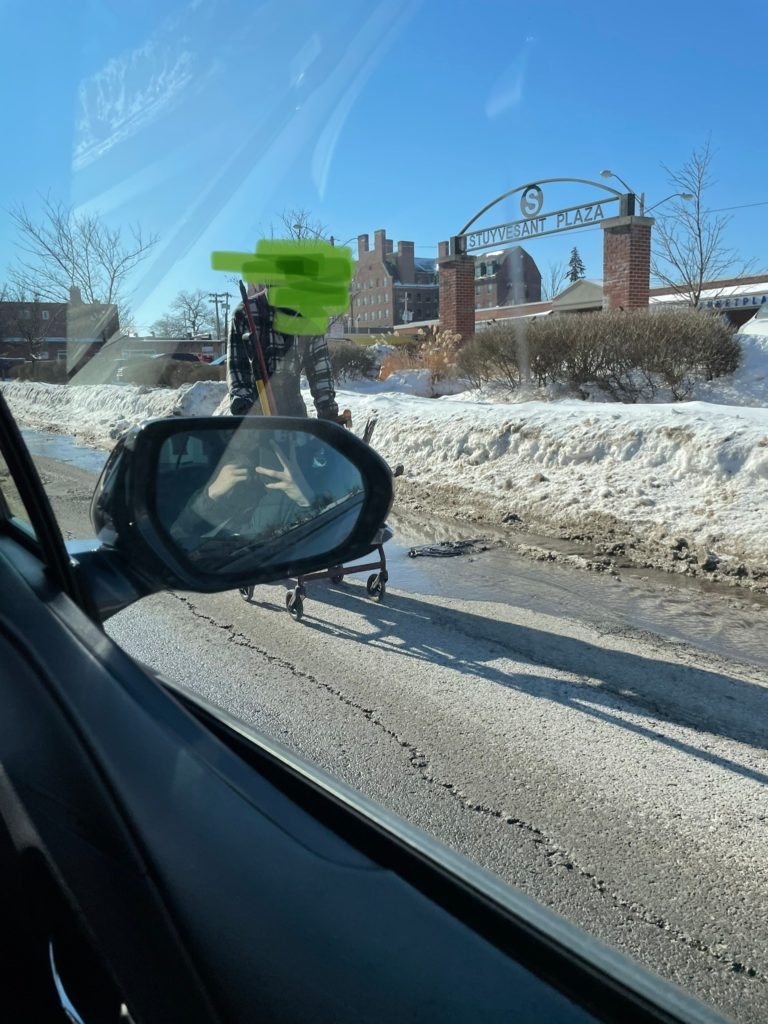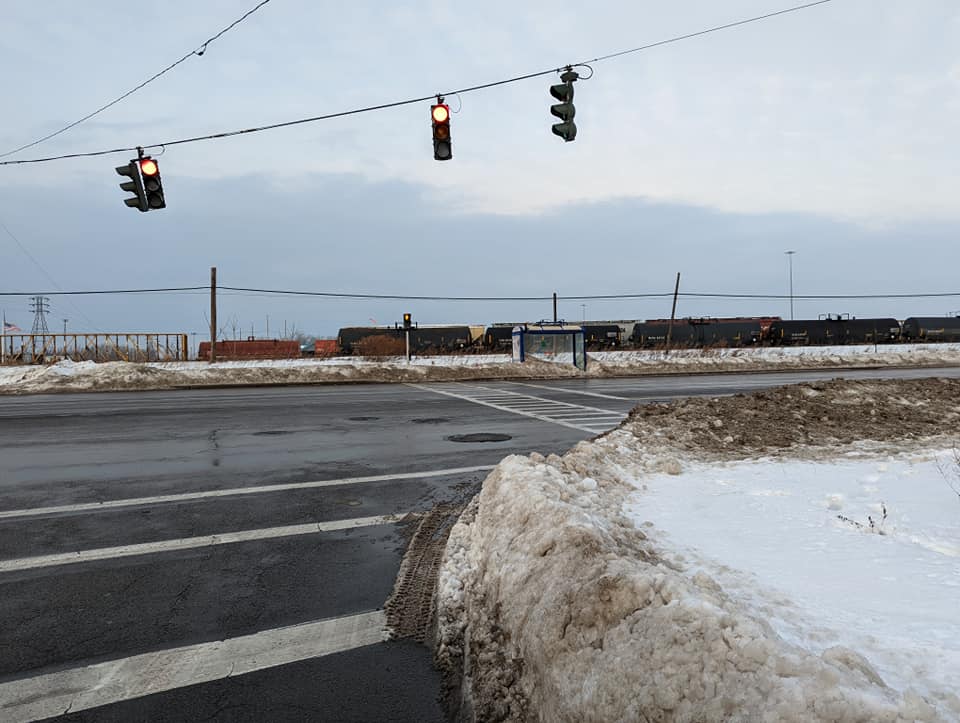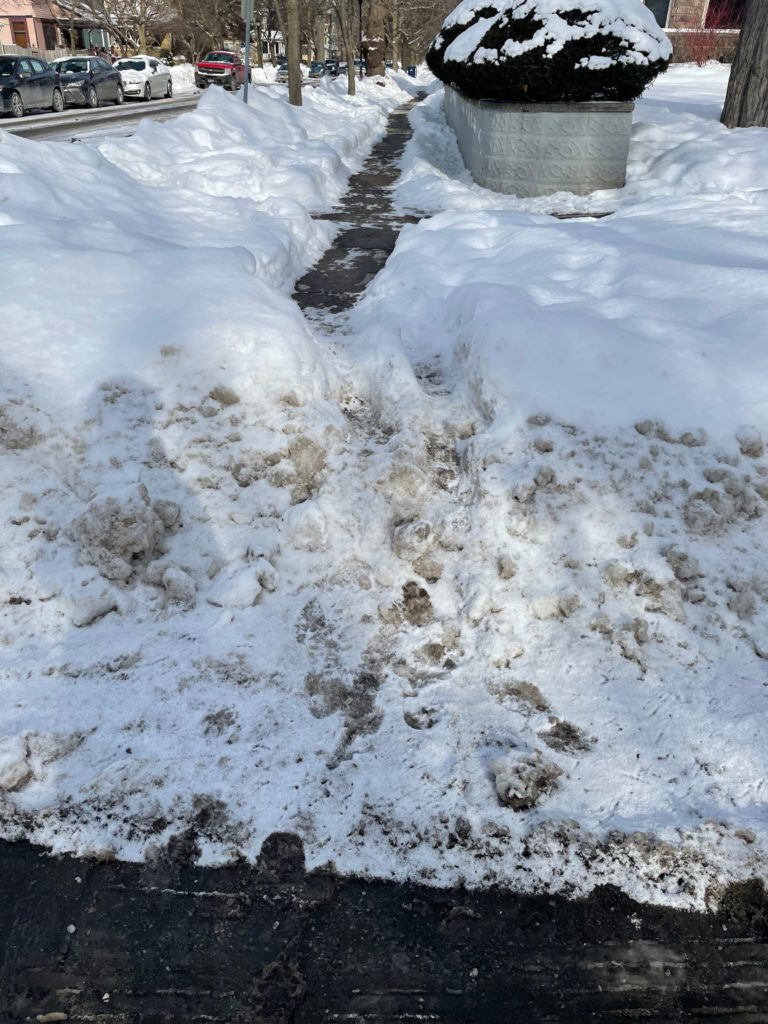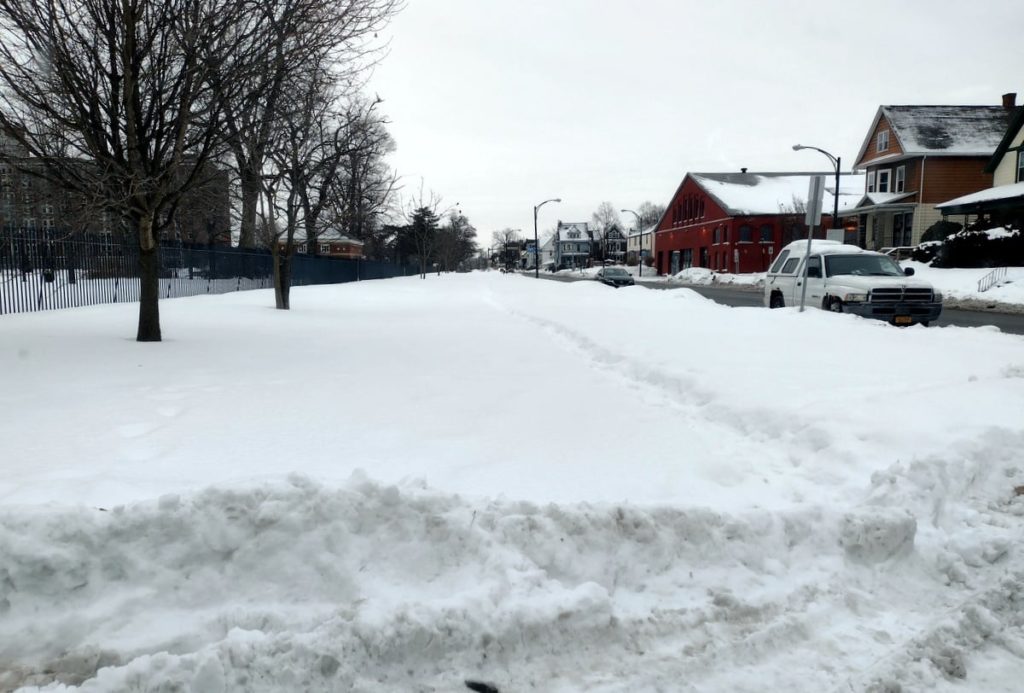This winter, still not half over, has made it abundantly clear that Buffalo can no longer rely on property owners to clear their sidewalks, which are owned by the city.
While the city worked to just get roads clear, pedestrians were left with nowhere to go. Either trudge through the feet of snow and ice on what used to be a sidewalk, or step into a street, cleared or uncleared, and hope car drivers took mercy enough to slow down and dodge you.

Credit: Lin Dita, Posted in Sidewalk of Shame group on Facebook.
Amidst a dramatic rise in reckless driving state-wide, and a corresponding jump in traffic violence and deaths, we cannot continue to relegate pedestrians into the streets in a city where dealing with snow was once something we prided ourselves on doing well.
There’s hope for the future. Rochester and Syracuse have already implemented municipal snow removal programs, and Buffalo’s time may be coming soon.
A board of the city council, the Bicycle and Pedestrian Advisory Committee is charged with the review of on-going and future infrastructure projects to ensure they best accommodate the needs of all roadway users including pedestrians, bicyclists, and people with disabilities. Meetings are open to the public and held on the first Tuesday of each month at 5:30 pm.

Credit: Marek Sawicki, Posted in Sidewalk of Shame group on Facebook.

Credit: Simon Husted, Posted in Sidewalk of Shame group on Facebook.
Golombek is sick about the current state of affairs.
Last night, North District Councilmember Joe Golombek attended. He made a critical revelation that upon seeing a constituent in his district in a wheelchair wait for the bus in the street, entirely exposed to oncoming traffic, he was sick over how we were treating that person, people around the city with disabilities, and non car-drivers in general.
Golombek’s been leading the charge to pilot a snow removal program. In June, he was joined by Councilmembers Wingo, Wyatt and Nowakowski.
Here’s the resolution that was most recently tabled on January 4, 2022:
Last night, the Bike Ped Board joined the movement with a unanimous resolution of support to fund municipal snow removal in this year’s budget.
It was prefaced by this letter from our Executive Director Justin Booth:
Dear City of Buffalo Common Council members:Walkable neighborhoods aren’t just something nice but are critical pieces of infrastructure that keep cities moving in all weather conditions. This is why snow removal from sidewalks should be a budget priority in Buffalo as it is in cities as nearby as Rochester and Syracuse. Our latest snow events continue to underscore the negative impact that not having a sidewalk snow removal program in place has on people in our city including:
- Bus riders walk to and from their stops. At the bus stops themselves, dangerous amounts of snow and ice often pile up. Sitting down inside a shelter may become impossible. Getting on and off a bus becomes challenging.
- People using wheelchairs and walkers have trouble crossing streets if curb cuts are not clear. This goes against the principles of the Americans with Disabilities Act.
- Seniors are less able to go outside and walk when their neighborhood sidewalks are slippery. Thus, an important component of healthy aging is compromised.
- Healthy living for people of all ages is another consideration. Outdoor activities during our long and cold winter could be greatly enhanced if citizens knew they could be safe outside.
Back in June of 2021 the board sent a letter conveying our unconditional endorsement of Councilmember Golombek’s resolution to implement a sidewalk snow removal program. At February’s monthly meeting of the Council’s Bicycle and Pedestrian Advisory Board, we unanimously passed the attached resolution again in support of establishing a sidewalk snow removal program in the City of Buffalo.The board urges you establish sidewalk snow removal as a priority for this coming year’s budget.Thank you
Justin Booth
ChairBicycle and Pedestrian Advisory Board

Credit: Lin Dita, Posted in Sidewalk of Shame group on Facebook.
And here’s the resolution itself:
Bicycle & Pedestrian Advisory Board
Sidewalk Snow Removal Resolution – unanimously approved on 2/1/2022
Whereas, Buffalo has a significant population considered vulnerable roadway users with nearly one third of households without access to a vehicle, 22.6% under 18 years of age, 12.4% over 65 years of age and 12.9% living with a disability;
Whereas, The latest snow storm in Buffalo which dropped well over a foot of snow crippled the city with people home from work and children off from school all because we cannot move vehicles from our streets;
Whereas, Cities as nearby as Syracuse are utilizing new technology, powered by GPS trackers in all city snow plows, that allow residents to find how recently their streets have been cleared of snow, and;
Whereas, The City of Syracuse has allocated $650,000 annually to clear snow from a hundred miles of heavily travelled sidewalks;
Whereas, If we had built, or began to rebuild our city centered around people, not cars, we wouldn’t have been so terribly crippled by this latest snow storm;
Whereas, Walkable neighborhoods aren’t just something nice but are critical pieces of infrastructure that keep cities moving in all weather conditions;
Now Therefore, Let It Be Resolved that the City of Buffalo’s Bicycle and Pedestrian Advisory Board urges the City Council and Mayor to allocate the appropriate resources to establish a sidewalk snow removal program and invest in the necessary technology to ensure that the city’s most vulnerable roadway users continue to have access to their daily needs.

Credit: Kevin Hayes, Posted in Sidewalk of Shame group on Facebook.
So what can you do?
Contact your city council representative! Ask them to also commit to supporting municipal snow removal in this year’s budget.
Contact the mayor’s office! Ask him to also commit to supporting municipal snow removal in this year’s budget.
Call 311 wherever you see a neglected (or worse, buried by a private plow service) sidewalk, curb ramp, bus shelter, bus stop! 311 is effective in getting things done, and it’s also a data mine. The more calls it receives for things like this, the more likely it will be prioritized in future budgets.
This is a matter of protecting our citizens, our neighbors, and keeping the city accessible to everyone, regardless of the weather.
There are pages and accounts and groups all over social media where people are discussing this. Please share this article and this call to action with them, but remember that your representative isn’t crawling social media to see what they should do next. They should be contacted directly.